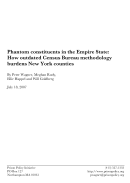
Importing Constituents:
Prisoners and Political Clout in Wisconsin
By John Hejduk and Peter Wagner
Prison Policy Initiative
March 2008
Section:
Census Bureau counts Wisconsin prisoners in wrong place; access to state and county government distorted
The federal Census counts state and federal prisoners as part of the local population, and that creates big problems for state and local government, charges a new report by the Prison Policy Initiative.
“Governments rely on the Census to count the population so they can update legislative districts,” said Prison Policy Initiative Executive Director and report co-author Peter Wagner. The Supreme Court’s “One Person One Vote” rule requires that legislative districts each contain the same number of people, so that each person has the same access to government. “Unfortunately, the Census Bureau has counted 20,000 prisoners in the wrong place,” said Wagner.
Historically, Wisconsin’s state legislative districts are drawn by federal judges and far more equal in population than in most states. “Only 4 states drew more perfect districts” said report co-author John Hejduk. “But we found a district where 10% of the population is prisoners; that’s a problem 5 times larger than what the federal judges who drew the districts were trying to avoid.”
“The problem is even larger in some rural areas,” said Wagner. The report, Importing Constituents: Prisoners and Political Clout in Wisconsin, finds rural county and city government districts that are as much as 79% prisoners. “This allows the real residents of a district with a prison to unfairly dominate their local government.”
The report calls on Wisconsin to lobby the Census Bureau to change how prisoners are counted; and urges counties and cities with prisons to follow the lead of Michigan’s counties and draw legislative districts that are not based on flawed Census counts of prisoners.
Contact:
Peter Wagner
(413) 527-0845
-30-
Events
- April 15-17, 2025:
Sarah Staudt, our Director of Policy and Advocacy, will be attending the MacArthur Safety and Justice Challenge Network Meeting from April 15-17 in Chicago. Drop her a line if you’d like to meet up!
Not near you?
Invite us to your city, college or organization.



